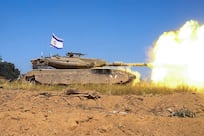Last July, a video appeared on YouTube showing a friendly tug-of-war game between members of two Islamist groups, Jabhat Al Nusra and Islamic State of Iraq and Syria. The game, held amid cheering children, ends in a tie and a caption that says: "By the grace of God, they tied and no one prevailed."
The video was made at a festival held by Al Qaeda's Syrian and Iraqi branches in an Aleppo neighbourhood as part of an effort to portray jihadist movements in a softer light.
This was one of a series of media messages intended to camouflage the widening schism among extremist Sunni rebel groups in Syria, especially between Jabhat Al Nusra and the Islamic State of Iraq and Syria (ISIS), both Al Qaeda affiliates.
Jabhat Al Nusra is an Al Qaeda associate operating in Syria. The group announced its creation in January last year during the Syrian civil war. Led by Mohammed Al Golani, a Syrian from the Golan Heights, it is described as the most aggressive and successful arm of the rebel force. It has been was designated by the US as a terrorist group.
The ISIS was established as an umbrella organisation of Iraqi insurgent groups in October 2006, under the name of Islamic State of Iraq. In April 2013 it changed its name to reflect its involvement in the Syrian civil war. It is led by Abu Bakr Al Baghdadi, an Iraqi born in Samarra.
Both groups are supposedly fighting for the same purpose: the fall of the Assad regime and the establishment of Sharia law in Syria.
However, sequences of events on the ground and recent media reports indicate that each of the groups is serving its own agenda. More importantly, these reports dispel the widely held belief that Al Qaeda and its affiliates function as one united family that completely submits to the hierarchy of command with Ayman Al Zawahiri at its top. The internal struggle within the terrorist organisation is real and documented.
In April 2013, the leader of ISIS, residing in Iraq, released an audio statement announcing that Jabhat Al Nusra is its branch in Syria.
The leader of Al Nusra denied the merger but confirmed his group's allegiance to the Al Qaeda leader. But within weeks, factions of Jabhat Al Nusra joined the ranks of the ISIS and began acting under its name. The move was interpreted as an attempt by ISIS to merge the two organisations, despite Al Zawahiri's instructions to the contrary.
The global Al Qaeda-led jihad movement is witnessing sharp divisions that seem no longer containable. For two main reasons, Al Zawahiri can't allow the leader of ISIS, with its mainly Iraqi fighting force, to annex Al Nusra with its mainly Syrian fighters to his virtual state.
The first reason is of a practical nature: a merger of Al Qaeda-affiliated Islamist groups in Iraq and Syria would focus effective power in the hands of Mr Al Baghdadi, turning Al Zawahiri into a mere symbolic leader with no real leverage on the ground.
The second reason is ideological. Syria, known in religious texts as Al Sham, holds a special sentimental and religious value for fervent extremist fighters. They regard the Syrian war as an act of obedience to the Prophet's commandments and a realisation of his vision.
In jihadist ideology, then, the fight in Syria takes precedence to any other fight. Syria has indeed become the largest ground for jihadist battles in the world and the man who prevails on this battlefield will hold effective power.
Hence, it is in Al Zawahiri's interest to contain Mr Al Baghdadi, the leader of ISIS, and to keep him as far as possible from the Syrian arena. This would also win him the allegiance of Mr Al Golani, the leader of Jabhat Al Nusra - although there are no guarantees that he would be able to stand his ground against Mr Al Baghdadi who enjoys the support of the majority of jihadists in Syria and seems to be indifferent to Al Zawahiri's instructions.
The haemorrhage of militants has been catastrophic for Jabhat Al Nusra. Reports indicate that the rate of change of allegiance for the Islamic State has reached 80 per cent among non-Syrian fighters and 50 per cent among Syrian fighters. The shift created confusion in Al Nusra's ranks and gave rise to conflicts with some Free Syrian Army brigades.
Despite the competition and clear attempt by ISIS to swallow Jabhat Al Nusra, the groups still carry out joint operations to ensure that neither one of them gets sole credit for any victory, no matter how small.
Things clearly don't seem to be heading towards a merger between the two groups. If anything, the future seems to hold more division that may end in final separation and the departure of one of them from the global school of jihad.
Should the divisions continue within Al Qaeda and its branches, Al Zawahiri's school in its present form may even disintegrate and collapse.
This article originally appeared in Al Hayat newspaper. The author is political editor of Al Bayan, in Dubai
* Translated by Racha Makarem (rmakarem@thenational.ae)




